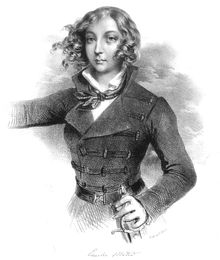Emilia Plater
| Countess Emilia Plater |
|
|---|---|

Emilia Plater, anonymous 19th century engraving
|
|
| Born |
13 November 1806 Vilnius, Russian Empire |
| Died |
23 December 1831 (aged 25) Justianowo, Congress Poland |
| Buried at | Kapčiamiestis (Kopciowo) |
| Allegiance | Poland (November Uprising insurgents) |
| Years of service | 1830 |
| Rank | captain |
| Battles/wars | November Uprising |
Countess Emilia Plater (Broel-Plater, Lithuanian: Emilija Pliaterytė; 13 November 1806 – 23 December 1831) was a Polishnoblewoman and revolutionary from the lands of the partitioned Polish–Lithuanian Commonwealth. Raised in a patriotic Polish tradition, she fought in the November 1830 Uprising, during which she raised a small unit, participated in several engagements, and received the rank of captain in the Polish insurgent forces. Near the end of the Uprising, she fell ill and died.
Though she did not participate in any major engagement, her story became widely publicized and inspired a number of works of art and literature. She is a national heroine in Poland and Lithuania, all formerly parts of the Polish-Lithuanian Commonwealth. She has been venerated by Polish artists and by the nation at large as a symbol of women fighting for the national cause.
Emilia Plater was born in Vilnius (Wilno) into a noble Polish–Lithuanian Plater family. Her family, of the Plater coat of arms, traced its roots to Westphalia, but was thoroughly Polonized. Much of the family relocated to Livonia during the 15th century and later to Lithuania, of which Vilnius is the capital. She is described as either Polish, Polish-Lithuanian or Lithuanian.
Her parents, Franciszek Ksawery Plater and Anna von der Mohl (Anna z Mohlów), divorced when she was nine years old, in 1815. She was brought up by distant relatives, Michał Plater-Zyberk and Izabela Helena Syberg zu Wischling, in their family's manor Līksna near Daugavpils (Dźwina), then Inflanty (now Latvia). Well-educated, Plater was brought up to appreciate the efforts of Tadeusz Kościuszko and the Prince Józef Poniatowski. She was fascinated by Johann Wolfgang von Goethe and Friedrich Schiller, who she could read in the original German language. She was raised in an environment that valued the history of Poland, and her literary heroes included Princess Wanda and Adam Mickiewicz's Grażyna. She also admired Bouboulina, a woman who became one of the icons of the Greek uprising against the Ottomans, a Polish fighter Anna Dorota Chrzanowska, as well as Joan of Arc. These pursuits were accompanied by an early interest in equestrianism and marksmanship, quite uncommon for early 19th-century girls from aristocratic families. She was also deeply interested in Ruthenian and Belarusian folk culture. She had contacts and friends in the Filaret Association.
...
Wikipedia
